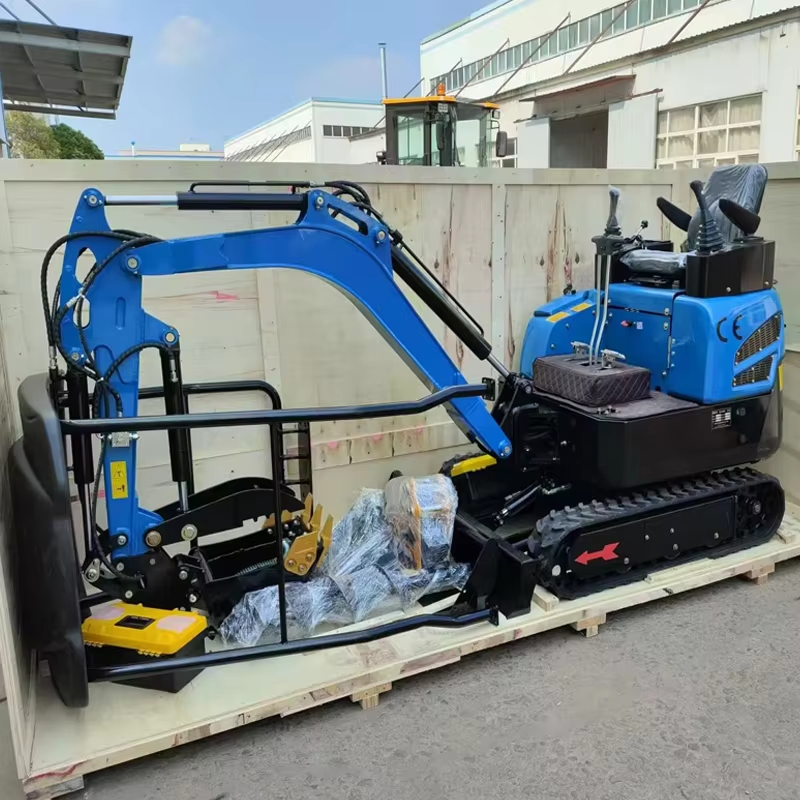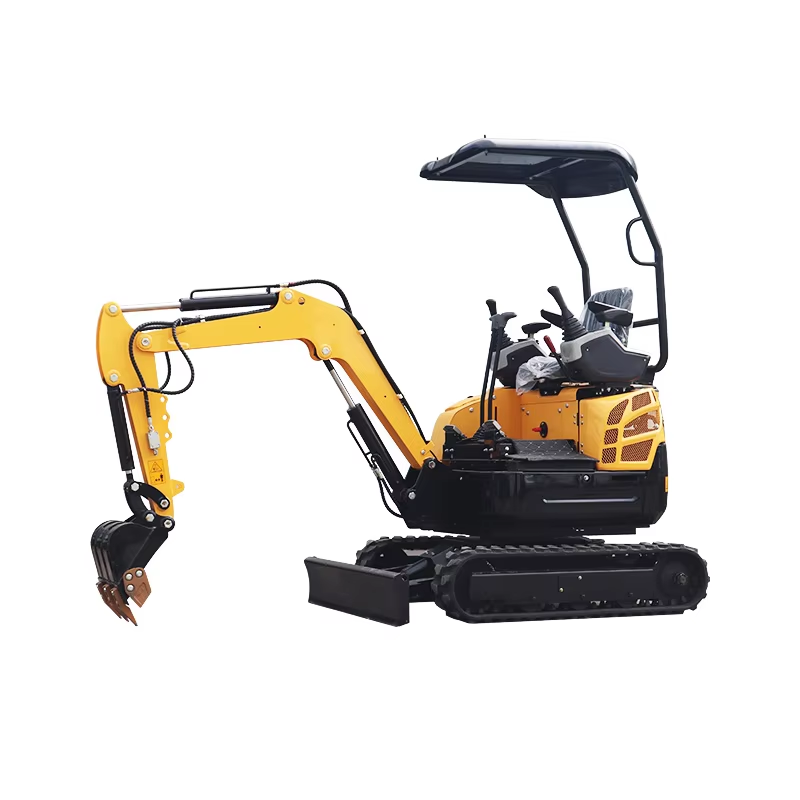Understanding Small Excavator Controls
Joystick Functions and Hydraulic Systems Explained
Getting to know how joystick controls work makes all the difference when running a small excavator around job sites. These joysticks handle basic but important stuff such as moving the machine forward/backward, controlling the digging action, and adjusting the big arm (boom) position. Usually there's one stick for steering and another that handles lifting the boom up/down plus rotating it side to side. With both sticks working together, operators can really get into tight spots and move material just right. Most experienced diggers will tell anyone starting out that mastering these controls takes time because getting those fine adjustments right matters a lot during tricky jobs like making straight trenches or leveling ground surfaces properly.
How the joystick connects to the hydraulic system determines how well a small excavator actually works in the field. Moving the controls triggers signals that send hydraulic power throughout different parts of the machine. This whole setup lets operators dig, lift, and move materials with both strength and control. Hydraulic performance varies quite a bit across brands and models. Some manufacturers have invested heavily in better hydraulic tech to get more out of their machines. Industry reports show that certain compact excavators now feature improved hydraulic systems which cut down on fuel burn. Less fuel means lower running costs and smaller carbon footprint over time, making these machines more attractive for construction sites concerned about both budget and sustainability.
ISO vs. SAE Control Patterns: What Beginners Need to Know
New operators working with smaller excavators really need to get their head around the different control setups known as ISO and SAE patterns. Let's start with ISO, which stands for International Standards Organization. This setup shows up all over the globe and generally puts boom movement and machine rotation under control of the left hand lever. Meanwhile, the right hand lever handles arm extension and bucket operation. On the other side of things we have SAE from Society of Automotive Engineers. This one dominates North American equipment where operators will find the left lever controlling arm movement and rotation instead. The right lever takes care of boom positioning and bucket functions here. Most folks pick this up faster when they actually see diagrams showing how these layouts differ side by side. Many training programs include these visual aids to help new drivers avoid confusion during their first real digging sessions.
When deciding between ISO and SAE control patterns, operators need to think about how comfortable they feel during long shifts and how quickly they pick things up. A lot of folks gravitate toward ISO controls since the movements tend to follow a more natural rhythm, which helps cut down on tired arms after hours at the machine. On the flip side, workers who have spent time around construction sites often get used to SAE layouts because they match the way hands move naturally while doing tasks like digging or lifting materials. Most trainers will tell newbies that starting with ISO makes sense as these controls usually make sense right away, particularly if someone has operated other big equipment before. At the end of the day though, what works best really depends on individual preferences and what kind of jobs someone typically does. The best approach? Get hands-on experience with both styles whenever possible to see which one clicks better with daily work routines.
Pre-Operation Safety Checks and Setup
Assessing Your Worksite for 1-Ton Mini Excavator Safety
Before getting started with a 1 ton mini excavator, taking time to look around the worksite really matters when it comes to staying safe. There are several things worth checking first. The ground needs to be stable enough to support the machine without sinking or shifting. Look up too for any potential dangers hanging overhead such as tree limbs or electrical wires that might get damaged during operation. Also important is knowing where underground utilities run beneath the surface so nobody accidentally digs into something they shouldn't. We've seen plenty of incidents at job sites where people skipped these basic steps and ended up causing serious problems. Want to stay on top of things? Let me share what I usually check off before starting work with one of these machines:
1. Ground Stability: Ensure the area is firm to support the weight of the mini excavator.
2. Overhead Hazards: Identify and eliminate potential risks like wires or low-hanging branches.
3. Utility Check: Confirm the absence of underground utilities in your working vicinity.
4. Clearance: Ensure ample space for maneuvering and storing equipment.
5. Access to Exit Routes: Guarantee that exit routes remain unobstructed for emergencies.
Worksite Safety Statistics: According to the Occupational Safety and Health Administration (OSHA), approximately 20% of worker fatalities in 2019 were in construction, emphasizing the crucial role of adhering to stringent safety checks.
Essential PPE and Equipment Inspection Protocols
Operating a small excavator entails wearing essential personal protective equipment (PPE) to minimize risk. Essential PPE includes hard hats, gloves, safety glasses, steel-toed boots, and high-visibility vests. Proper PPE ensures you're shielded from debris, machinery hazards, and environmental exposure.
Safety and efficiency go hand in hand when it comes to equipment inspection protocols. The process should begin with looking at those key parts including tracks, fluids, and filters. Tracks need to be set just right based on what the manufacturer says, while checking oil, fuel, and coolant levels becomes essential work. Don't forget to look at filters too, making sure they're clean and sitting properly in place. Industry standards back these practices up, something organizations like NIOSH have been emphasizing for years now. They know that regular checkups help stop accidents before they happen and keep machines running longer without breakdowns. When workers stick to these safety rules day after day, injuries drop off considerably and things actually run better across the worksite overall.
Basic Operating Techniques for New Operators
Mastering Digging and Trenching with Electric Mini Excavators
Getting good results with electric mini excavators during digging and trenching jobs takes some practice with certain techniques. Make sure the machine sits stable on whatever surface it's working on this helps keep things accurate and safe across different kinds of ground conditions. When using the controls, go slow and steady instead of jerking around if sudden moves happen, precision goes right out the window. New folks often mess up by holding the bucket at wrong angles or digging too much just watch out for those mistakes they really hurt efficiency. According to industry numbers, workers who know their stuff can boost productivity somewhere around 20% so learning these tricks definitely pays off in the long run.
Electric mini excavators bring environmental advantages while boosting productivity across construction sites. When operators master efficient digging methods, they save power and actually prolong equipment life, plus protect the surrounding area from unnecessary damage. Better yet, these practices make work go smoother day after day and help build a greener industry overall. Good old fashioned preparation combined with solid execution makes all the difference in getting excavation jobs done right the first time around.
Maneuvering in Tight Spaces: Track Control Fundamentals
Getting good at track control makes all the difference when working with small excavators in tight areas where there's little room for error. Operators need to keep their movements precise to prevent accidental damage to equipment or surrounding structures while staying safe on site. Most experienced operators suggest building up skill by practicing slow movements first in open spaces before moving into more challenging environments. The separate operation of right and left tracks means operators must constantly monitor both sides during turns, since even minor differences in speed between tracks can dramatically change how sharp or wide the machine turns.
Visual aids really help when trying to grasp different maneuvering techniques. Diagrams or videos showing spatial relationships make it easier to see what's happening on site. They show operators how to manage those tracks properly so they can navigate tight spaces without damaging anything around them. Most people learn best by doing, so hands-on experience works wonders. But pairing that with good training materials makes all the difference for someone just starting out with small excavators. New operators need time to get comfortable working in tough conditions while still maintaining control over their machines.
Common Mistakes to Avoid with Compact Equipment
Overloading Buckets: Risks and Load Capacity Guidelines
Putting too much weight in the bucket of a small excavator creates all sorts of problems that nobody wants to deal with later. The added strain from overloading puts serious pressure on the machine itself, which often results in breakdowns or just plain wears things out faster than normal. And let's face it folks, when those buckets get too heavy, the whole rig becomes unstable, putting everyone around at risk. Operators really need to pay attention to those manufacturer specs about how much weight each bucket can actually handle without causing trouble. We've seen plenty of cases where people ignore these limits and end up with damaged equipment and injured workers. According to some research looking into construction accidents, nearly one out of every six incidents was caused by someone loading their bucket wrong. Getting this right isn't just about keeping machines running smoothly; it makes the entire worksite safer for everyone involved.
Ignoring Terrain Limitations: Stability Best Practices
Knowing the limits of different terrains makes all the difference in keeping compact equipment from tipping over or causing accidents during operation. Before jumping into any job, operators should take a good look at the ground conditions first, particularly if they're dealing with muddy spots or rocky patches where machines tend to lose their balance. Good practice means keeping the machine's weight balanced low to the ground and steering clear of those quick U-turns or sudden jerks when things get rough. On hillsides specifically, nobody wants to be driving sideways across the slope. Better to go straight up and down hill instead. Looking around carefully and checking out topographic maps ahead of time really helps plan how best to approach tricky areas. Most experienced folks will tell anyone who listens that taking it slow and steady works wonders for staying stable. These simple steps protect both the machinery itself and everyone working nearby from potential harm.
Maintenance Essentials for Long-Term Performance
Daily Maintenance Checklist for Small Excavators
Small excavators will last longer if operators stick to regular daily maintenance routines. Having a good checklist makes all the difference when it comes to spotting problems early before they turn into big headaches down the road. The basics are pretty straightforward really. Check those fluid levels first thing every morning. Look closely at the hydraulic hoses too because even tiny leaks can cause major issues later. Don't forget to get underneath and examine the undercarriage for cracks or worn spots that might compromise stability. Operators should also make time to inspect attachments regularly since damaged tools just won't perform right no matter how well maintained the rest of the machine is. Some industry research suggests that sticking to these daily checks can cut repair bills substantially over time. One study found maintenance costs dropped around 20% for machines that received consistent attention. So while nobody likes spending extra time on maintenance work, taking those few minutes each day pays off handsomely in both wallet savings and equipment lifespan.
Lubrication and Battery Care for Electric Models
Keeping electric mini excavators well lubricated and taking good care of their batteries makes all the difference when it comes to smooth operation and getting the most out of them. When we regularly apply oil to those moving parts, it cuts down on friction which means less wear and tear over time, plus fewer breakdowns that nobody wants. Battery health matters too because if we ignore this part, performance drops off pretty quickly and before long we're looking at spending money on expensive replacements. For lubrication work, someone needs to check how much oil there actually is in the system and make sure every component gets what it needs. With batteries, it's important to look at voltage readings and give those terminals a good clean so corrosion doesn't start eating away at connections. Some folks who know what they're talking about say that following these basic steps can extend battery life somewhere around 30 percent. That kind of longevity really highlights why regular maintenance should never be skipped for anyone running electric excavators day in and day out.

